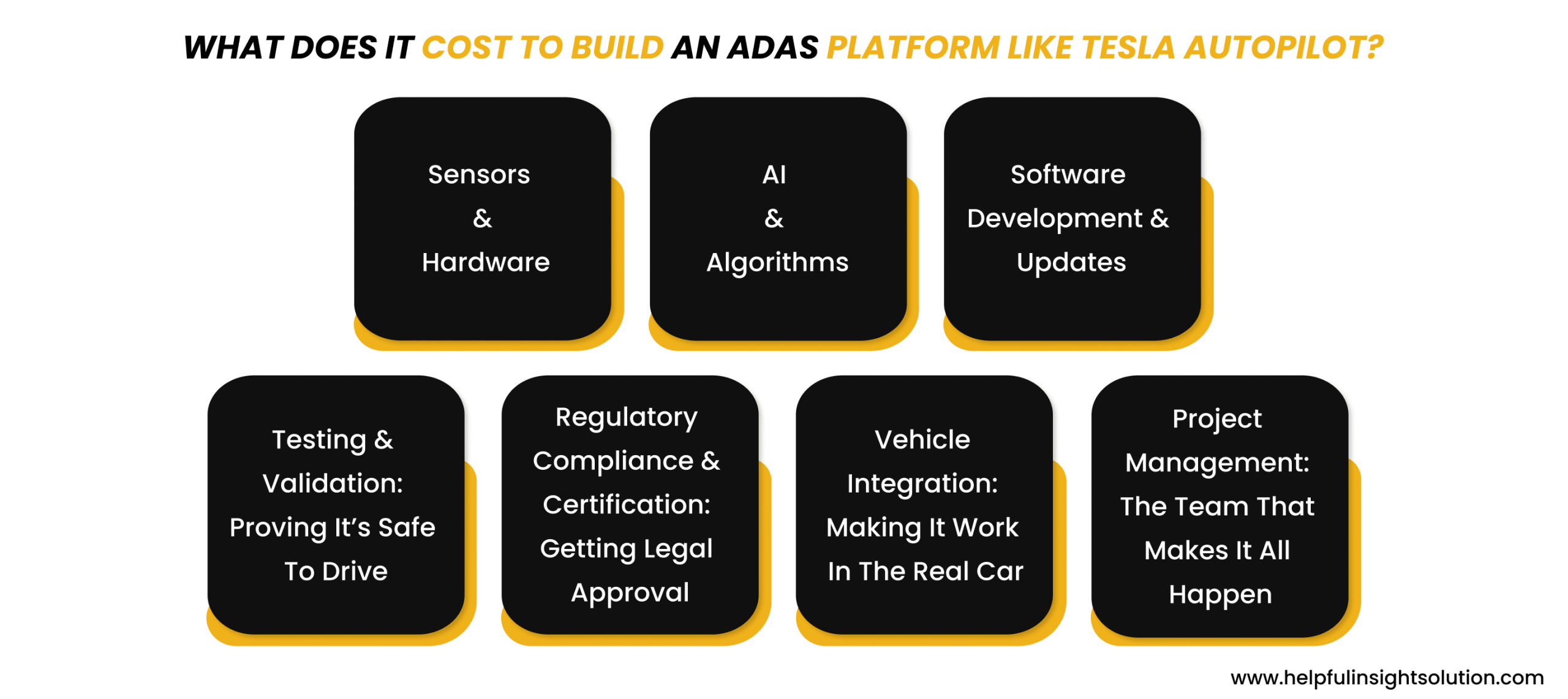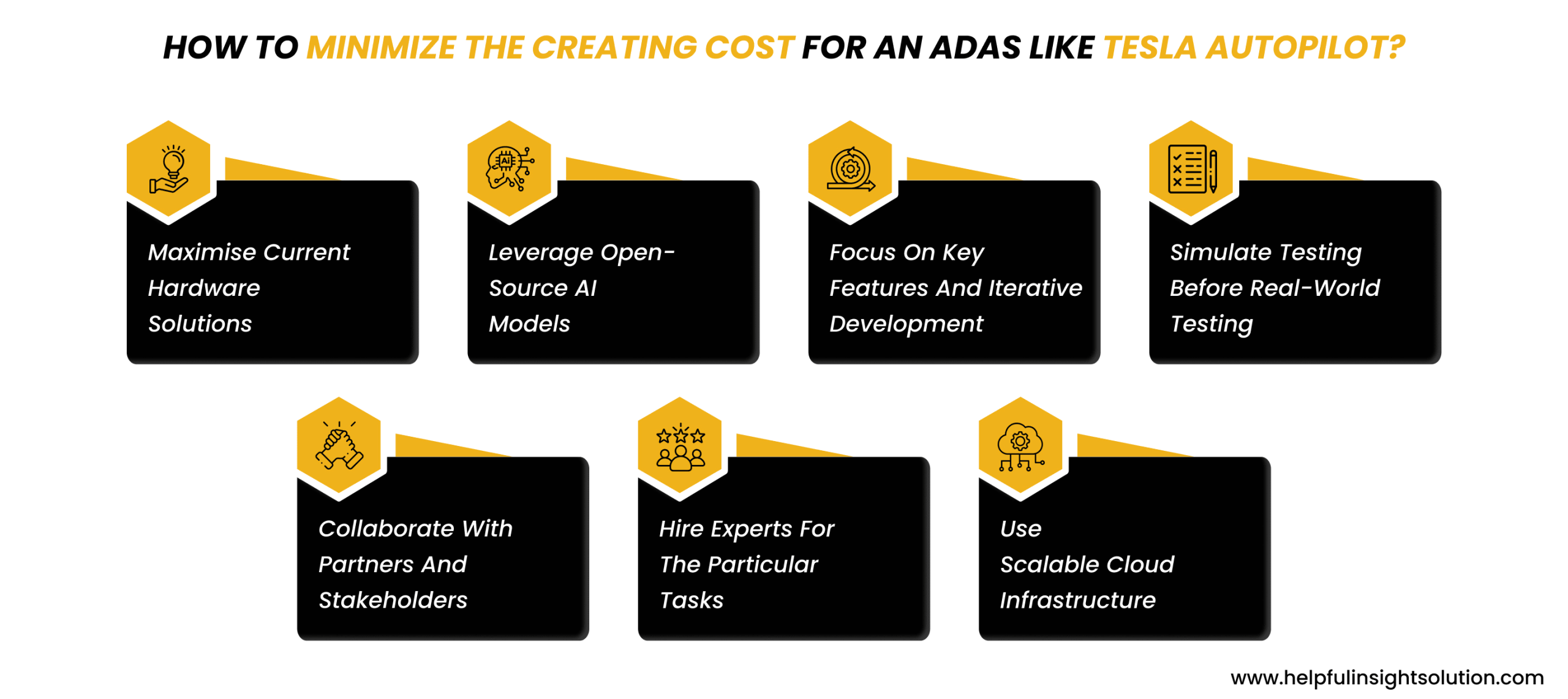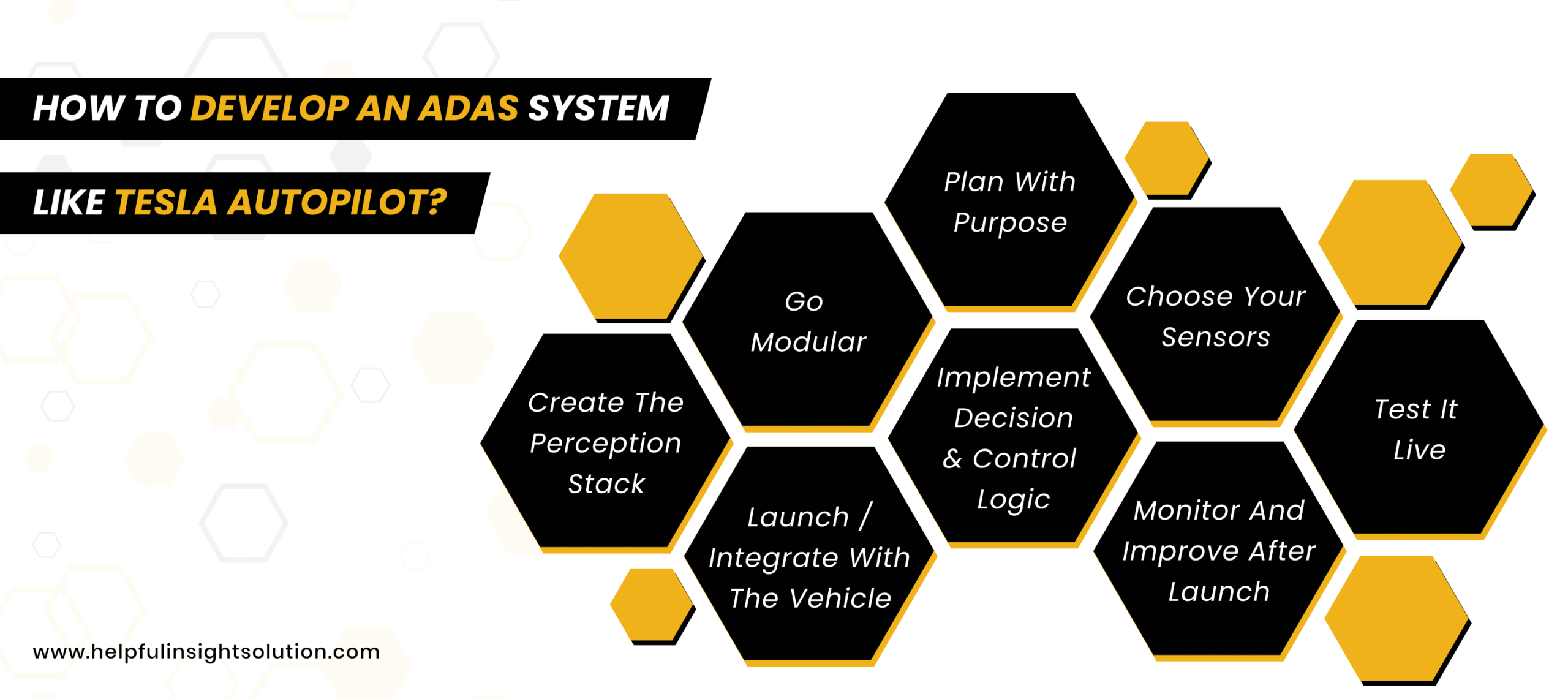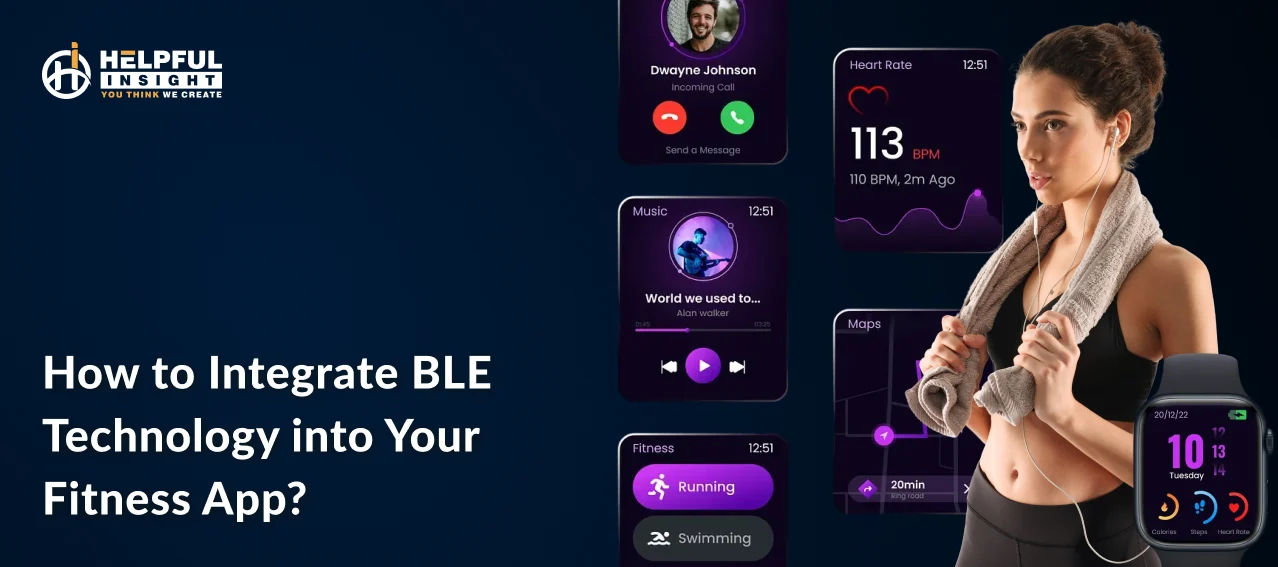Tesla Autopilot is the future of driving. It merges the cameras, sensors, and next-gen software to build an advanced driver assistance system. With various businesses exploring this segment for its obvious reason, the next question that naturally comes is: how much does it cost to Build An Advanced Driver Assistance System Like Tesla Autopilot?
Tesla Autopilot is the future of driving. It merges the cameras, sensors, and next-gen software to build an advanced driver assistance system. With various businesses exploring this segment for its obvious reason, the next question that naturally comes is: how much does it cost to build an advanced driver assistance system like Tesla Autopilot? Whether you’re a startup or an established firm, the first thing you need to know is how much it will cost to create a driver assistance system like Tesla’s. This will help you plan and design your own version.
In this article, we will breakdown the cost to build a driver assistance system like Tesla. Shall we begin the drive? Let’s dive in!
What is an Advanced Driver Assistance System?
Traffic-Aware Cruise Control is also recognised as Advanced Driver Assistance System, and it helps a vehicle to maintain a steady speed and safe distance from the car coming in the front. While a driver stays attentive on the road and drives, the system will adjust vehicle speed without driver input to change the speed and break; and overtake other drivers. Drivers will have the features such as traditional cruise control, and the vehicle adjusts to follow the traffic rules. Before getting into the cost to build a ADAS like Tesla part let’s understand the
statistics:
- In 2021, one Tesla Autopilot-enabled crash occurred every 4.19 million miles, compared to one crash every 978,000 miles for vehicles without active safety features, while the U.S. national average was 484,000 miles per accident.
- Another research confirms ADAS market at USD 36 billion in 2024, growing to USD 88.9 billion by 2034, at a CAGR of 9.5%.
- According to McKinsey, only about 5.5% of cars sold in 2024 included Level 2+ features like cruise control and automatic lane changes but this is projected to climb dramatically to 57% adoption by 2035 in a high-growth scenario.
Breaking Down the Cost to Build An Advanced Driver Assistance System Like Tesla
If you’re thinking about the cost of an advanced driver assistance system, in short answer: this can be anywhere around $30,000 to $250,000 or more. But spending on ADAS advanced driver assistance systems is not an expense, it’s an investment in futuristic technology that will be the new reform in the coming future.
Developing an ADAS platform like Tesla autopilot involves more than coding. It integrates high-end sensors – cameras, radar, and LiDAR, creating professional AI algorithms, developing high-end data infrastructure, and frequently upgrading the software. Beyond the main features, cost includes the feature of rigorous testing and adhering to the compliance with regulatory standards, a must have for the safety and market readiness.
After all this, the ROI is amazing from heightened road safety and driving advancement to a smoother, great driving experience. It’s an important step for experiencing complete automatic drive.
Breakdown of Key Development Components and Their Cost Impact
| Development Component | Details | Cost Impact |
| AI Algorithm Development | Leveraged intelligence and object detection, decision-making, and path planning. | High because of the complexity and need for customization. |
| Sensor Integration | Integrating cameras, radar, and LiDAR for capturing surroundings. | High sensors come at a premium price. |
| Data Processing Infrastructure | Algorithms for processing massive sensor data streams in real time. | Medium Hardware accommodation variety is available. |
| Software Development | Adding features such as adaptive cruise control and lane-keeping assistance. | High because of frequent updates and developer price. |
| Testing & Simulation | Real-world testing to ensure reliability and safety. | Depending upon the resource and other grounds. |
| Regulatory Compliance | Complying with the safety and legal standards across regions. | Medium legal fees and regulatory complexity. |
| Project Management & Overheads | Managing teams, timelines, and resources throughout development. | Low to High depending on project scope. |
What Does It Cost to Build an ADAS Platform Like Tesla Autopilot?
Creating an intelligent driver assistance system isn’t just about assembling some sensors and writing code. It’s about building an intelligent system that understands road presence, environment, calculates split-second decisions, and learns something new like humans.
That kind of technology is not bound by cost. In fact, ranging from complexity and scale, the cost to develop an advanced adas advanced driver assistance system like Tesla Autopilot can be anywhere from $30,000 to well over $250,000. So, what makes it so costly?
Below mentioned are the key factors that define the cost and why it’s important.

1. Sensors & Hardware
For an intelligent software to “observe” the road, it requires a rich combination of sensors like cameras, radar, and LiDAR. These devices process the surroundings such as environment, vehicles, people, road signs, weather conditions, and more. The sensors have to be top notch to avoid any miss happening.
2. AI & Algorithms
On the first glance, everybody can agree that adas tech is artificial intelligence. Which uses algorithms such as sensor data, recognize objects, predict movement, and take split-second decisions such as when to brake, steer, or slow down. Developing adas advanced driver assistance system has to include the best AI models available in the market.
3. Software Development & Updates
The software that runs an ADAS platform is never “completed.” To run glitchfree it requires continuous updates to fix bugs, add new features, or comply with updated regulations if something comes up. And when it comes to the ADAS case, these updates are deployed over the air (OTA), which creates another layer of engineering complexity and of course extra cost.
4. Testing & Validation: Proving It’s Safe to Drive
Testing is where the real-world risk meets reality. Before an ADAS system can hit public roads, it must undergo hundreds (or thousands) of hours of simulations and real-world driving to make sure it’s safe for the streets. Testing isn’t just about functionality or the formality, it’s about understanding this system is very crucial and can have a severe impact on people’s life if anything goes wrong.
5. Regulatory Compliance & Certification: Getting Legal Approval
Even if your system is running as expected and has not failed any single test, you cannot sell or deploy it without getting green signal by legal and safety checks. This cost can vary across countries, states, and even cities. Navigating these legal mazes can take a major chunk of your time and is expensive.
6. Vehicle Integration: Making It Work in the Real Car
The ADAS platform needs to work seamlessly with all the vehicle’s existing systems including brakes, steering, acceleration, infotainment, diagnostics, and more. This process would be different for every vehicle model and can quickly increase the final cost.
7. Project Management: The Team That Makes It All Happen
Finally, nothing big can be achieved without the help of great minds behind. With a team of specialists such as AI engineers, hardware designers, automotive experts, regulatory consultants, project managers work simultaneously to create a flawlessly designed solution. Having that level of talent by your side and coordination could be one of the major investment in the process.
Explore More: How to Hire Mobile App Developers in Dubai: Cost and Key Steps
How to Minimize the Creating Cost for An ADAS Like Tesla Autopilot?
Put simply, an AI agent like Tesla Autopilot is a costly, complex thing to build. Still, there are some strategies that drastically cut down the cost of development. Any aspiring client can save heavily using a few handy tactics, including leveraging existing technologies. Additionally, collaborating with partners and only prioritizing key features can further reduce costs.
Additionally, collaborating with the best software or mobile app development company and prioritizing key features can further reduce costs.
Affordability becomes easy with the following tips:

1] Maximise Current Hardware Solutions
Wherever possible, going with off-the-shelf equipment like cameras, radar, and LiDAR is the best. Procure high-quality solutions from established vendors to speed up development while minimising financial overhead.
2] Leverage Open-Source AI Models
With the easy availability of open-source machine learning models, using them is a no-brainer to reduce development costs. You needn’t create a neural network from scratch, as pre-existing models can be easily customized to fit your needs.
3] Focus On Key Features and Iterative Development
Prioritise key features, including obstacle detection, automatic braking, and lane-keeping. Utilise the nature of iterative releases to introduce core features first, thus bringing down initial development costs.
4] Simulate Testing Before Real-World Testing
Be sure to ‘road-test’ your product rigorously with simulations. Replicate as many real-world scenarios here as possible to test your systems and ensure their efficiency and robustness.
5] Collaborate With Partners and Stakeholders
Reach out for collaboration with established hardware manufacturers, AI firms, and research institutes. These partnerships can be invaluable, as they allow you to share resources, reduce risks, and tap into expertise all while reducing costs.
6] Hire Experts for the Particular Tasks
Some tasks, such as sensor calibration, AI model training, and product testing, are best performed with the help of top software development companies or experienced developers. These firms excel at doing these tasks at a much lower cost, freeing you to build core systems instead.
7] Use Scalable Cloud Infrastructure
Tap into cloud services, as they provide computing power that’s both scalable and reliable, in turn reducing your need for expensive on-site hardware. Most providers offer pay-as-you-go models, which allow you to flexibly adjust based on requirements, depending on whether demand is high or low.
Explore More: How to Choose the Right Mobile App Developers in Australia
Key Features of an AI Agent Like Tesla Autopilot
Tesla Autopilot does more than the driver-assist system. It’s an innovative blend of hi-tech features that help the car analyze its surroundings and make driving easy and safe. Here are key features you’ll likely find in an AI agent like Tesla Autopilot:
Here are key features you’ll likely find in an AI agent like Tesla Autopilot:
1. Adaptive Cruise Control
This feature helps to calculate the distance between the vehicles. Helps slow down or speeds up automatically as the traffic moves
2. Lane Keeping and Lane Centering
The system keeps the car within lane markings by gently adjusting the steering if the vehicle starts to drift.
3. Automatic Lane Changes
When the driver signals or when the car decides it’s safe, it can switch lanes on its own during highway driving.
4. Object and Environment Detection
The system can identify other vehicles, pedestrians, cyclists, traffic lights, stop signs, and more. It uses cameras and AI to understand what’s happening around the car in real time.
5. Navigation on Autopilot
This combines Autopilot features with navigation. The car can guide itself through highway interchanges, exits, and traffic, based on the route set in the GPS.
How to Develop An ADAS System Like Tesla Autopilot?

1. Plan With Purpose
Start by outlining what features you want, such as adaptive cruise control, lane centering, or autopark. Develop Minimum Viable Product (MVP) with core features first. This lets you understand user behaviour, get real-world data, and scale it later as the feedback comes.
2. Go Modular
Design into separate segments – perception, decision-making, control, and updates. This will help you to upscale features independently. Moreover, It eases the testing, debugging, and future upgrades
3. Choose Your Sensors
Create a perfect combination of different sensors: cameras for lane and sign detection, radar for reliable distance sensing, and optional LiDAR for 3D mapping. Keep the focus on redundancy and sensor fusion combining data streams to develop a consistent, real-time view of the surroundings.
4. Create the Perception Stack
Take open-source computer vision and ML models whenever required. Train your own neural networks using large, annotated datasets that work in all types of weather conditions: day, night, rain, snow, city, off roading. Sensor fusion ensures robustness in edge cases .
5. Implement Decision & Control Logic
Develop planning and control software that translates perception into driver-assist actions. This includes steering, acceleration, and emergency braking. Try to work with the modular, service-oriented architecture to enjoy a clean, scalable, and maintainable codebase.
6. Test It Live
Move to closed test tracks once Developing an ADAS Platform is almost done. After that, begin controlled real-world testing with safety precautions. Collect failure and edge-case data, then iterate. Repeat until performance and reliability is top-notch.
Once developing an ADAS platform is nearly complete, move to closed test tracks. After that, begin controlled real-world testing with safety precautions. Collect failure and edge-case data, then iterate. Repeat until performance and reliability is top-notch.
7. Launch / Integrate with the Vehicle
Integrate ADAS system to the vehicle’s braking, steering, CAN/Ethernet network, and infotainment. This step asks for the calibration and custom tuning for each vehicle model to provide precise and trusted performance.
8. Monitor and Improve After Launch
Once it’s live, frequently take driving data and user feedback. Take use of telemetry to identify issues and lags. Iterate on your models and software. Deliver updates as per the users requirement —rather than guesswork.
Why Choose Helpful Insight for Building An ADAS System Like Tesla Autopilot?
Looking to create an Advanced Driver Assistance System? Being the top-rated AI agent development company, Helpful Insight has all the required skills for developing a ADAS platform like tesla autopilot. We are known for creating innovative, scalable AI-driven systems that reflect power and performance.
We are here to deliver comprehensive driver assistance technology be it integrating advanced driver-assistance systems (ADAS), autonomous navigation, or machine learning algorithms, we have the right expertise to meet and exceed all your expectations. With decade-old industry expertise, Helpful Insight ensures unmatched development quality, regulatory compliance, and seamless integration. Making us the best company for your AI-driven project.
FAQ
The project time could vary because of complexity, but developing an Advanced Driver Assistance System can be somewhere 12 to 24 months, depending upon the app type and features.
ADAS takes the leverage of (cameras, radar, LiDAR), ECUs/SoCs, and software (RTOS, AUTOSAR, AI/ML) for real-time updation, control, and safety. It takes into consideration automotive standards like ISO 26262, uses CAN/Ethernet communication, and works with the AI models for detection and decision-making.
Developing an ADAS (Advanced Driver Assistance System) or an intelligent driver assistance system benefits road safety, complies with the regulatory compliance, and increases inclusion of all types of drivers. Furthermore, it enables scalable automation, provides data-driven improvements, and unlocks new revenue through features such as OTA improvements and driver assist services.













